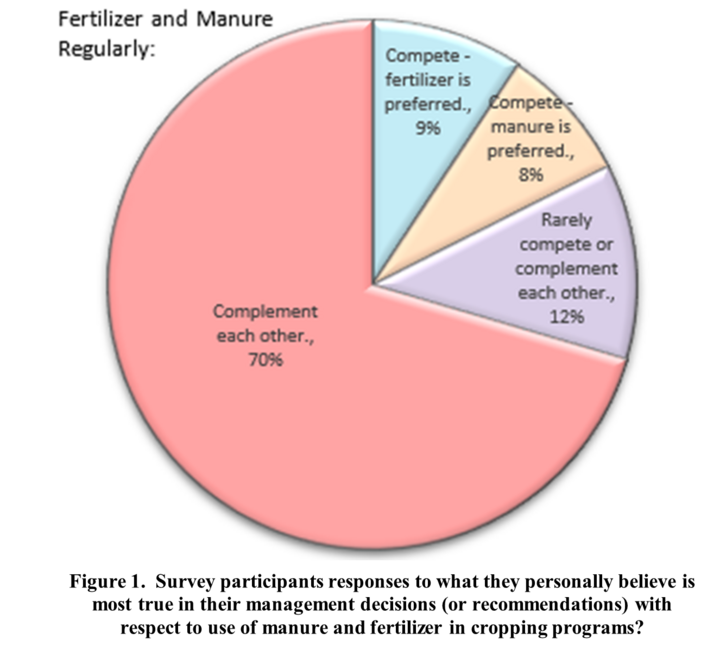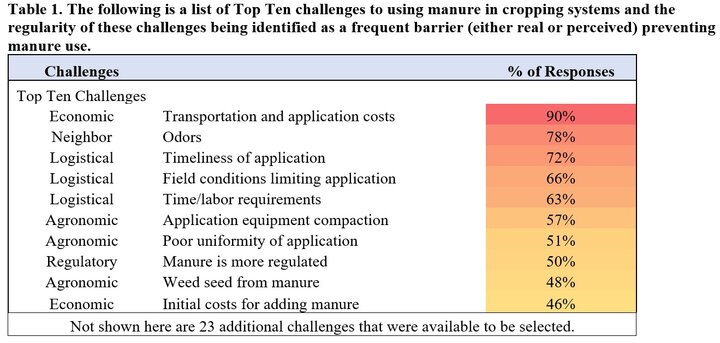Animal manures can be a valuable asset or a “pain in the assets”. During winter of 2020, 957 farmers and their advisors shared their perspective on the benefits and barriers to manure use. A previous article (part 1) focused on perceptions of manure’s benefits. This article (part 2) focuses on their perceptions of manure’s challenges that commonly become barriers to manure use in some fields and discusses strategies for preventing manure from becoming a “pain in the assets”. We invite you to learn more about:
- How farmers/advisors compare manure and fertilizer;
- When manure becomes a barrier for use in crops; and
- Where do we go from here to expand manure’s use in crop production.
How Do Manure and Fertilizer Compare?

The survey asked “Which of these statements do you personally believe is most true in your management decisions (or recommendations) with respect to use of manure and fertilizer in cropping programs?” With most individuals answering the survey being regular users of manure, it is probably not surprising that 70% responded that “Fertilizer and manure regularly complement each other in crop fertility programs” (Figure 1). Only a small group viewed manure and fertilizer as competitive with an equal number indicating manure versus fertilizer being preferred.
This complementary use of manure and fertilizer is a strategy with important advantages. Two recent reviews of more than 1,000 research trials comparing manure and fertilizer found that the largest crop yield occurred when manure and fertilizer complement each other. Planning a fertility program that takes advantage of the strengths of both manure and fertilizer improves the opportunity for yield gains for new users of manure.
When Is Manure a Barrier?
A wide range of challenges associated with animal manure use can prevent its use in some fields. Thirty-three potential challenges were shared in the survey and those responding selected those challenges that commonly prevented manure use on some fields. The “Top Ten Manure Barriers” shared in Table 1 provide some insights into common challenges for those interested in using manure.
Transportation Costs: The cost of transporting manure is barrier #1. As manure is moved greater distances, when do costs exceed manure value?
Is our perception of manure cost based upon an understanding of services available today? Businesses providing manure hauling and land application services have greatly expanded in their availability and the ability to move large volumes across significant distances in many regions. It may be appropriate to re-assess available services and before eliminating manure as a fertility option.
Odor: Farmers typically desire to be good stewards and good neighbors. Neighborhood concerns with manure odors is a significant barrier for expanding manure use. Options for incorporating manure into the soil should be considered. Recognition that odors are a part of manure application, even with best practices in place, is also crucial. Understanding weather conditions that lead to air inversions and odor concentration at ground level and how to use a weather forecast for avoiding those high risk times can minimize this challenge (see Timing Manure Application to Avoid Neighbor Nuisances).
Logistical Barriers: A range of logistical challenges, three of the top five concerns, ranked near the top as common barriers to using manure. Timely manure nutrient application for agronomic needs when confronted with labor, equipment, and field condition restrictions is tricky business. Like the 4 R’s of fertilizer application (Right Rate, Time, Source, and Place), manure application at the “right time” is critical to expanding manure use on new acres. Robust business services that facilitate brokering, transport and land application can help with timing challenges. Expanding the application window, such as Growing Season Manure Application Options, presents additional flexibility for manure use.
Agronomic Issues: Manure application comes with a history of agronomic concerns such as compaction, poor uniformity, and potential for weed seed and herbicide resistance concerns. Many agronomic issues are likely to be regionally and manure source specific, thus the need to adapt to local needs. Strategies such as Precision Technologies for Managing Manure, towed-hose manure application, Designer Manures, and composting may have value based upon local or regional needs.

Where Do We Go From Here?
The next important water quality improvement for management of animal manures will result as we utilize more crop acres, often managed by a different business from our animal feeding operations, in the recycling of manure N and P. For this to occur, our team proposes that:
- The agronomic, yield, soil health, and water quality benefits resulting from “agronomic” use of manure needs to be shared within our agricultural communities and with those making public policy choices.
Strategies addressing manure’s top challenges should be addressed with education and regional business services.
The authors wish to thank the Manure Manager magazine, ASA ICCA program, The Fertilizer Institute, and our many partners in Iowa, Minnesota, and Nebraska for promoting this survey.
Reviewers: Mary Keena, North Dakota State University Extension; Robert Meinen, Penn State University; Joe Harrison, Washington State University
